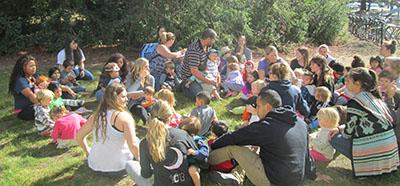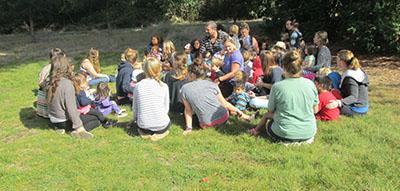Safety

Early childhood educators put the health and safety of children before any other consideration. All adults who are a part of the Children's School community are trained, coached and mentored to make sure the activities and the environments are safe.
Children are also encouraged to learn to judge and understand how to keep themselves safe in a variety of situations that might include earthquakes, fires, and taking risks.
Firedrill

Emergency Procedures
Emergency drills are practiced three times during a semester: one fire, one earthquake, and one shelter-in-place.
Blood-Related Injuries
For the safety of the children and staff, only staff members and parents of the injured child are permitted to handle blood injuries at school. When a blood-related injury occurs, staff will follow these steps:
1. Put on disposable gloves.
2. Turn the child away from your face to avoid having blood splashed or vomited into one's eyes, nose or mouth.
3. Disinfect any surface that has been contaminated with blood.
4. Dispose of all soiled items into a sealed plastic bag.
5. Place sealed plastic bag into a lined garbage can with lid.
6. When gloves are not available- create a barrier between your hands and the blood using any immediate items around you such as a towel, washcloth, paper towels, napkins, clothing (your own or the child's) and then thoroughly wash hands with soap.
7. Complete an Ouch Report or Unusual Incident/Injury Report.
If a staff member is exposed by direct contact, they will assume that blood is contaminated and are responsible for reporting the incident to the director by the end of their work shift.
Fire Drill Procedure
- When the fire alarm sounds, all children and teachers evacuate their classrooms, exiting to the outdoor play environments. Assigned teachers grab the emergency bags and join the children and other teachers in the outdoor play environments.
- Children and teachers line up by their exit gate for a head count and then proceed directly towards the Environmental Technology Center.
- Rosebuds, Dandelions and Poppies gather in their own circles, and teachers ensure all children are present.
- Assigned professional staff will check the building to ensure no children or staff are in the building and close doors in between rooms. They will then assist the classrooms for evacuation. A police officer will come to the gathering spot and give the “All Clear” signal before children and teachers return to the school.

Earthquake Procedure
The children will practice earthquake drills once a semester. The procedures will be the same in the event of an actual earthquake.
- The ground begins to shake (real or imagined).
- Children move to the center of the room, away from windows and "Duck and Cover" tuck chin to chest, cover head and back of neck with arms and hands, crouch to ground.
- When the ground stops shaking, and the pathways deemed safe, the teachers and children evacuate the building through their door to the playground and gather along the Poppy's north fence, children facing the parking lot A-X; their names are called to which they respond "Yes".
- Lia or Tarik will come to them and give the "All Clear" signal before children and teachers return to the school.
In the event of a real earthquake, where there is too much damage to re-enter the building, the children and teachers will stay along the fence until someone from Police Services comes. If damage is too extensive, all persons will be evacuated to the SSU Red Cross site. In the event you suspect the campus may be closed due to natural or other disasters, call the EMERGENCY INFORMATION LINE at 888-533-5388. Possible reasons to call may be severe weather conditions, power outages, flooding, or earthquake.
Shelter-in-Place Procedure
Once a semester, a practice drill "shelter in place" will be practiced. Master Teachers and administrative staff will lock all doors and close all curtains. Teaching staff will gather children away from the windows and initiate quiet activities until an all clear is issued.
Child Abuse Reporting
All staff, student employees, and interns are mandated reporters of child abuse because each has direct contact with children and families and so falls into the category of "child care custodian." The primary purpose of the Reporting Law is to protect the child. In addition, a report may provide needed intervention that will ultimately help the parents. All staff, students and volunteers are required to read and sign a STATEMENT BY PERSONS MANDATED TO REPORT UNDER CALIFORNIA PENAL CODE 1165 (K). They are required to report the following types of abuse:
- A physical injury.
- Sexual abuse including sexual assault and sexual exploitation.
- Willful cruelties or unjustifiable punishment.
- Corporal punishments or injury.
- Any of the above types of abuse or neglect that occur in out-of-home care.
When a staff member, student or interns believes that abuse or neglect may have occurred, the following steps will be taken:
- The person will immediately report their suspicion to the Director or the designated Teacher in charge. The indicators will be discussed to determine if there is REASONABLE SUSPICION that abuse or neglect has occurred. Documentation of indicators of abuse will be submitted to the Director for inclusion in the child's file.
- If there is reasonable suspicion, a phone report to the appropriate child protective agency must be made immediately or as soon as is practically possible. The director will make the report and document the conversation in the child's file. The parent may or may not be informed that a report has been made based on:
- the nature of the suspected abuse;
- the advice of Child Protective Services;
- the Director's recommendation;
- staff input.
- A written report must follow the phone report within 36 hours. The report must be sent to the child protection agency reported to, with copies sent to Community Care Licensing, and with one retained for the child's file.
- If a child protection agency worker or law enforcement officer is to come to the school to interview the child, the Director will remain on site until the interview and follow-up actions have been completed.
If the Director decides not to make a report, and the staff member, student or volunteer still believes that there is REASONABLE SUSPICION of abuse, neglect or exploitation, that individual is required to report their suspicion to the authorities.
1202 Apollo Way
Santa Rosa,CA 95407
INFORMATION: 565-4300.
P. O. BOX 1539
SANTA ROSA, CA 95402
CRISIS LINE: 1-800-870-7064 CPS Hotline: 565-4304.


